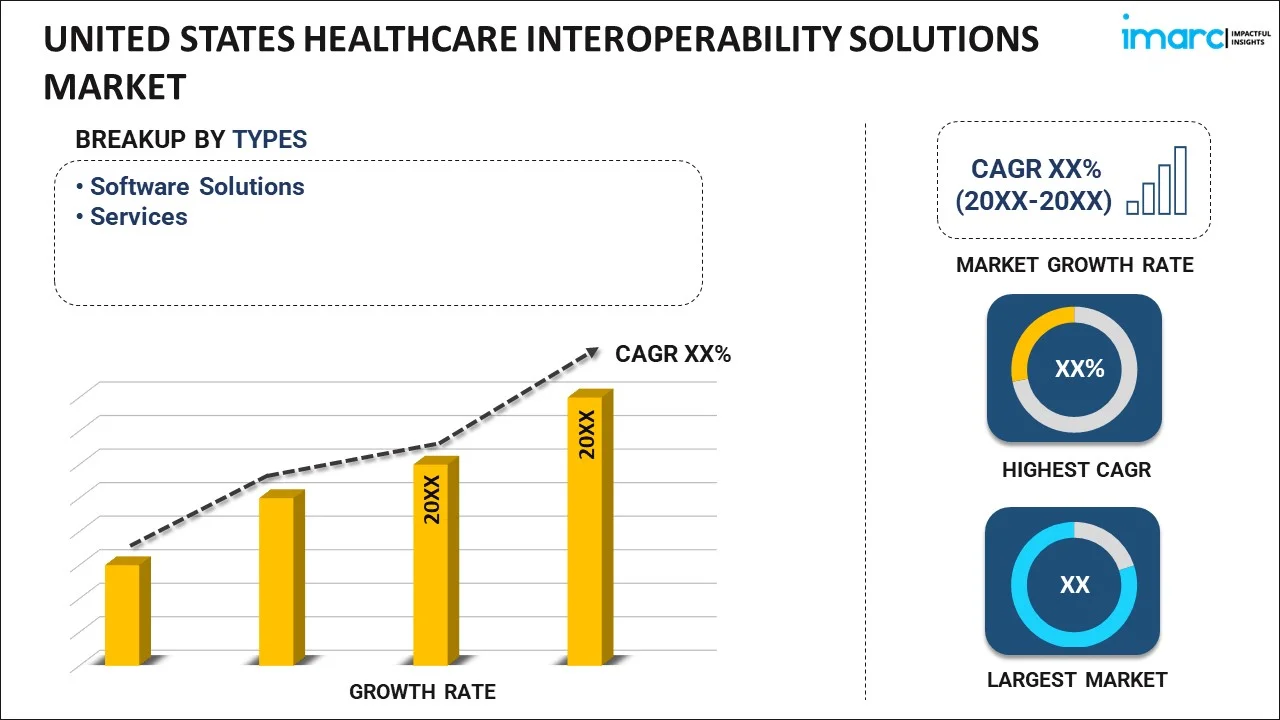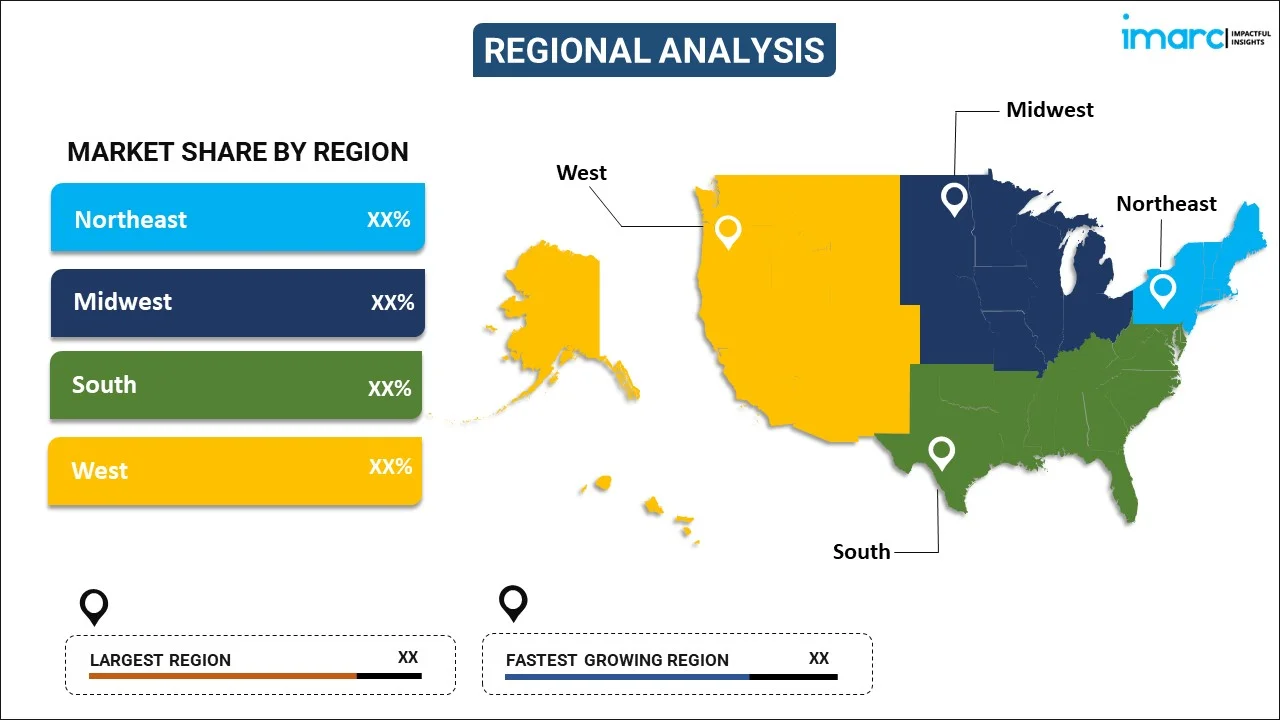
United States Healthcare Interoperability Solutions Market Report by Type (Software Solutions, Services), Level (Foundational, Structural, Semantic), Deployment (Cloud-based, On-premises), End Use (Healthcare Providers, Healthcare Payers, Pharmacies), and Region 2025-2033
Market Overview:
United States healthcare interoperability solutions market size reached USD 1,034.5 Million in 2024. Looking forward, IMARC Group expects the market to reach USD 2,735.6 Million by 2033, exhibiting a growth rate (CAGR) of 11.1% during 2025-2033. The growing utilization of big data analytics and machine learning (ML) in healthcare, rising focus on patient-centric care and the need for improved care coordination, and increasing employment by public health agencies to monitor health trends and manage outbreak represent some of the key factors driving the market.
|
Report Attribute
|
Key Statistics
|
|---|---|
|
Base Year
|
2024
|
|
Forecast Years
|
2025-2033
|
|
Historical Years
|
2019-2024
|
|
Market Size in 2024
|
USD 1,034.5 Million |
|
Market Forecast in 2033
|
USD 2,735.6 Million |
| Market Growth Rate 2025-2033 | 11.1% |
Healthcare interoperability solutions have the ability to exchange and use patient data seamlessly. They involve the smooth flow of information among different healthcare stakeholders, such as hospitals, clinics, laboratories, pharmacies, and patients, while ensuring data accuracy, privacy, and security. They are available in different types, such as point-to-point interfaces, electronic health records (EHR), health information service providers (HISPs), and health information organizations (HIOs). They reduce redundant tests, ensure accurate medication history, and enhance care coordination, leading to better patient outcomes. They can lower healthcare costs significantly by streamlining administrative tasks and avoiding duplicate tests. They help in reducing errors associated with manual data entry and promoting data accuracy. They provide healthcare professionals access to relevant patient data quickly, reducing delays in diagnosis and treatment. They enable patients to access their medical records, fostering engagement in their own healthcare decisions.
United States Healthcare Interoperability Solutions Market Trends:
At present, the rising utilization of big data analytics and machine learning (ML) in healthcare necessitates robust interoperability solutions to harness the full potential of these technologies. This represents one of the key factors impelling the market growth in the United States. Moreover, the growing focus on patient-centric care and the need for improved care coordination are driving the demand for interoperability solutions to ensure that patient data is accessible to all relevant parties, thereby improving decision-making and patient outcomes. Besides this, the increasing focus on cost reduction by healthcare providers is encouraging the adoption of interoperability solutions as they lower redundancies, minimize the need for manual data entry, and prevent errors caused by lack of access to complete patient information. This operational efficiency not only reduces costs but also improves the quality of care provided. Additionally, the rising utilization of interoperability solutions by pharmaceutical companies for better access to clinical data in drug research and development (R&D), clinical trials, and post-market surveillance is contributing to the market growth in the country. Apart from this, the growing integration of data from medical devices like wearables and monitors into EHR systems, assisting in remote patient monitoring and personalized medicine, is offering a favorable market outlook. The interoperability solutions enhance the utility of medical devices in patient care and enable the development of more sophisticated, data-driven devices. Furthermore, the increasing employment of interoperability solutions by public health agencies to monitor health trends, manage outbreaks, and conduct population health management is strengthening the growth of the market in the country. They are also used to improve disease surveillance, public health policies, and health intervention programs.
United States Healthcare Interoperability Solutions Market Segmentation:
IMARC Group provides an analysis of the key trends in each segment of the market, along with forecasts at the country level for 2025-2033. Our report has categorized the market based on type, level, deployment, and end use.
Type Insights:

- Software Solutions
- EHR Interoperability Solutions
- Lab System Interoperability Solutions
- Imaging System Interoperability Solutions
- Healthcare Information Exchange Interoperability Solutions
- Enterprise Interoperability Solutions
- Others
- Services
The report has provided a detailed breakup and analysis of the market based on the type. This includes software solutions (EHR interoperability solutions, lab system interoperability solutions, imaging system interoperability solutions, healthcare information exchange interoperability solutions, enterprise interoperability solutions, and enterprise interoperability solutions) and services.
Level Insights:
- Foundational
- Structural
- Semantic
A detailed breakup and analysis of the market based on level have also been provided in the report. This includes foundational, structural, and semantic.
Deployment Insights:
- Cloud-based
- On-premises
The report has provided a detailed breakup and analysis of the market based on the deployment. This includes cloud-based and on-premises.
End Use Insights:
- Healthcare Providers
- Hospitals and Clinics
- Long-Term Care Centers
- Diagnostic and Imaging Centers
- Others
- Healthcare Payers
- Pharmacies
A detailed breakup and analysis of the market based on end use have also been provided in the report. This includes healthcare providers (hospitals and clinics, long-term care centers, diagnostic and imaging centers, and others), healthcare payers, and pharmacies.
Regional Insights:

- Northeast
- Midwest
- South
- West
The report has also provided a comprehensive analysis of all the major regional markets, which include the Northeast, Midwest, South, and West.
Competitive Landscape:
The market research report has also provided a comprehensive analysis of the competitive landscape in the market. Competitive analysis such as market structure, key player positioning, top winning strategies, competitive dashboard, and company evaluation quadrant has been covered in the report. Also, detailed profiles of all major companies have been provided.
United States Healthcare Interoperability Solutions Market Report Coverage:
| Report Features | Details |
|---|---|
| Base Year of the Analysis | 2024 |
| Historical Period | 2019-2024 |
| Forecast Period | 2025-2033 |
| Units | Million USD |
| Scope of the Report | Exploration of Historical and Forecast Trends, Industry Catalysts and Challenges, Segment-Wise Historical and Predictive Market Assessment:
|
| Types Covered |
|
| Levels Covered | Foundational, Structural, Semantic |
| Deployments Covered | Cloud-based, On-premises |
| End Uses Covered |
|
| Regions Covered | Northeast, Midwest, South, West |
| Customization Scope | 10% Free Customization |
| Post-Sale Analyst Support | 10-12 Weeks |
| Delivery Format | PDF and Excel through Email (We can also provide the editable version of the report in PPT/Word format on special request) |
Key Questions Answered in This Report:
- How has the United States healthcare interoperability solutions market performed so far and how will it perform in the coming years?
- What has been the impact of COVID-19 on the United States healthcare interoperability solutions market?
- What is the breakup of the United States healthcare interoperability solutions market on the basis of type?
- What is the breakup of the United States healthcare interoperability solutions market on the basis of level?
- What is the breakup of the United States healthcare interoperability solutions market on the basis of deployment?
- What is the breakup of the United States healthcare interoperability solutions market on the basis of end use?
- What are the various stages in the value chain of the United States healthcare interoperability solutions market?
- What are the key driving factors and challenges in the United States healthcare interoperability solutions?
- What is the structure of the United States healthcare interoperability solutions market and who are the key players?
- What is the degree of competition in the United States healthcare interoperability solutions market?
Key Benefits for Stakeholders:
- IMARC’s industry report offers a comprehensive quantitative analysis of various market segments, historical and current market trends, market forecasts, and dynamics of the United States healthcare interoperability solutions market from 2019-2033.
- The research report provides the latest information on the market drivers, challenges, and opportunities in the United States healthcare interoperability solutions market.
- Porter's five forces analysis assist stakeholders in assessing the impact of new entrants, competitive rivalry, supplier power, buyer power, and the threat of substitution. It helps stakeholders to analyze the level of competition within the United States healthcare interoperability solutions industry and its attractiveness.
- A competitive landscape allows stakeholders to understand their competitive environment and provides an insight into the current positions of key players in the market.
Need more help?
- Speak to our experienced analysts for insights on the current market scenarios.
- Include additional segments and countries to customize the report as per your requirement.
- Gain an unparalleled competitive advantage in your domain by understanding how to utilize the report and positively impacting your operations and revenue.
- For further assistance, please connect with our analysts.
 Request Customization
Request Customization
 Speak to an Analyst
Speak to an Analyst
 Request Brochure
Request Brochure
 Inquire Before Buying
Inquire Before Buying




.webp)




.webp)












